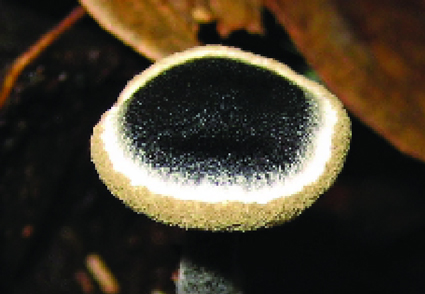Abstract
This is the third arthroconidial-producing agaric discovered for the genus Arthromyces found in the neotropics. Arthromyces pulverulentus from the cloud forests of Colombia is described and illustrated. The new species can be distinguished from other members of the genus Arthromyces by its thick mycelioid roll around the margin of the pileus that produces copious amounts of smooth phaeoarthrospores. This newly discovered species, like other members of the genus, is associated with insect-faecal pellet masses of an unidentified insect.
References
- Baroni, T.J., Franco-Molano, A.E., Lodge, D.J., Lindner,, D.L., Horak E. & Hofstetter, V. (2007) Arthromyces and Blastosporella, two new genera of conidia-producing lyophylloid agarics (Agaricales, Basidiomycota) from the neotropics. Mycological Research 111 (5): 572–580. https://doi.org/10.1016/j.mycres.2007.03.007
- Gardes, M. & Bruns, T.D. (1993) ITS primers with enhanced specificity for basidiomycetes—application to the identification of mycorrhizae and rusts. Molecular Ecology 2 (2): 113–118. https://doi.org/10.1111/j.1365-294X.1993.tb00005.x
- Hofstetter, V., Redhead, S.A., Kauff, F., Moncalvo, J.M., Matheny, P.B. & Vilgalys, R. (2014) Taxonomic revision and examination of ecological transitions of the Lyophyllaceae (Basidiomycota, Agaricales) based on a multigene phylogeny. Cryptogamie Mycologie 35 (4): 399–425. https://doi.org/10.7872/crym.v35.iss4.2014.399
- iNaturalist (2023) iNaturalist. iNaturalist Database. Available from: https://www.inaturalist.org (accessed 1 July 2023)
- Katoh, K., Rozewicki, J. & Yamada, K.D. (2019) MAFFT online service: multiple sequence alignment, interactive sequence choice and visualization. Briefings in Bioinformatics 20 (4): 1160–1166. https://doi.org/10.1093/bib/bbx108
- Kearse, M., Moir, R., Wilson, A., Stones-Havas, S., Cheung, M., Sturrock, S., Buxton, S., Cooper, A., Markowitz, S., Duran, C., Thierer, T., Ashton, B., Meintjes, P. & Drummond, A. (2012) Geneious Basic: an integrated and extendable desktop software platform for the organization and analysis of sequence data. Bioinformatics 28 (12): 1647–1649. https://doi.org/10.1093/bioinformatics/bts199
- Rehner, S.A. & Buckley, E. (2005) A Beauveria phylogeny inferred from nuclear ITS and EF1-alpha sequences: evidence for cryptic diversification and links to Cordyceps teleomorphs. Mycologia 97 (1): 84–98. https://doi.org/10.3852/mycologia.97.1.84
- Trifinopoulos, J., Nguyen, L.T., von Haeseler, A. & Minh, B.Q. (2016) W-IQ-TREE: a fast online phylogenetic tool for maximum likelihood analysis. Nucleic Acids Research 44 (W1): W232–235. https://doi.org/10.1093/nar/gkw256
- van de Peppel, L.J.J., Aime, M.C., Læssøe, T., Pedersen, O.S., Coimbra, V.R., Kuyper, T.W., Stubbe, D., Aanen, D.K. & Baroni, T.J. (2022a) Four new genera and six new species of lyophylloid agarics (Agaricales, Basidiomycota) from three different continents. Mycological Progress 21 (10): 1–14. https://doi.org/10.1007/s11557-022-01836-7
- van de Peppel, L.J.J., Baroni, T.J., Franco-Molano, A.E. & Aanen, D.K. (2022b) Genetic population structure of the agaric Blastosporella zonata (Lyophyllaceae) reveals cryptic species and different roles for sexual and asexual spores in dispersal. Persoonia 49: 195–200. https://doi.org/10.3767/persoonia.2022.49.06
- van de Peppel, L.J.J., Nieuwenhuis, M., Auxier, B., Grum-Grzhimaylo, A.A., Cardenas, M.E., de Beer, Z.W., Lodge, D.J., Smith, M.E., Kuyper, T.W., Franco-Molano, A.E., Baroni, T.J. & Aanen, D.K. (2021) Ancestral predisposition toward a domesticated lifestyle in the termite-cultivated fungus Termitomyces. Current Biology 31 (19): 4413–4421. https://doi.org/10.1016/j.cub.2021.07.070
- Vilgalys, R. & Hester, M. (1990) Rapid Genetic Identification and Mapping of Enzymatically Amplified Ribosomal DNA from Several Cryptococcus Species. Journal of Bacteriology 172 (8): 4238–4246. https://doi.org/10.1128/jb.172.8.4238-4246.1990
- White, T.J., Bruns, T.D., Lee, S.J.W.T. & Taylor, J.L. (1990) Amplification and direct sequencing of fungal ribosomal RNA genes for phylogenetics. PCR protocols: a guide to methods and applications 18 (1): 315–322. https://doi.org/10.1016/B978-0-12-372180-8.50042-1


